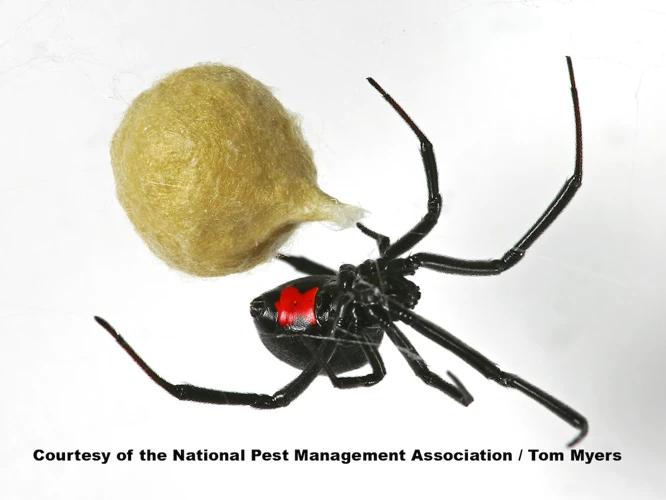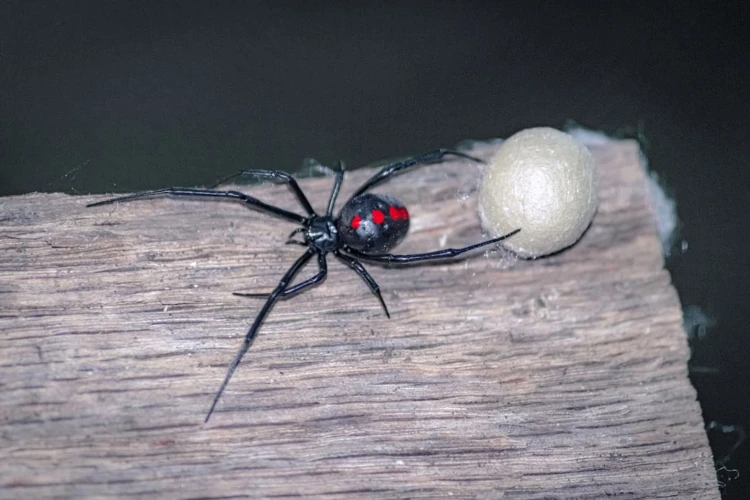As you explore the outdoors, you may come across various arachnids with unique physical features and characteristics. Among these is the Black Widow Spider, notorious for its venomous bite and unmistakable appearance. But have you ever stumbled upon a Black Widow Spider egg sac? These sacs contain hundreds of eggs which will soon hatch into the spider’s offspring. The visual appearance and texture of the egg sacs can be intriguing and intimidating at the same time. In this article, we will explore in detail the visual appearance and texture of Black Widow Spider egg sacs, as well as what you should do if you come across one.
Black Widow Spider Egg Sacs: Characteristics and Identification

Black Widow Spider Egg Sacs: Characteristics and Identification
As one of the most widely recognized and feared spider species, black widows are known for their venomous bites and their distinctive webbing. Their egg sacs are also a remarkable feature, as they play a crucial role in the reproductive cycle of the species. Understanding the visual appearance and texture of black widow spider egg sacs is essential for identifying them and distinguishing them from other spider species’ egg sacs. In this section, we will explore the key characteristics to look out for when trying to identify black widow spider egg sacs and provide insights into their uniqueness and relevance to the spider’s life cycle.
Appearance
Black Widow Spider Egg Sacs are approximately the size of a ping-pong ball and can contain anywhere from 200 to 900 eggs. The egg sacs are typically spherical in shape and are white to off-white in color. The color of the sac can be affected by the age of the eggs. As the eggs age, the sac may take on a yellowish color, which can be a sign that the eggs are close to hatching. Often, the sac is covered with a layer of webbing that appears to be haphazard.
It is important to note that the visual appearance of the Black Widow Spider Egg Sac can vary greatly depending on several factors. The color and texture of the sac can change according to the temperature, humidity, and other environmental factors in which it is found. Additionally, the maternal care of the spider plays a significant role in the appearance of the sac.
Research suggests that the visual signals of egg sacs provide important information to the spiders and other predators that may come across them. Egg sacs that are laid in a more secure location, such as under a rock, tend to have a thicker layer of webbing, and those that are laid in a more exposed location tend to have a thinner layer of webbing. This is likely a protective adaptation to help prevent predation and protect the developing spiderlings.
Studies have shown that the egg sacs of Black Widow Spiders can vary in appearance depending on the stage of development they are in. For instance, the color and texture of the sac may change as the eggs hatch and the spiderlings develop. This is because as the eggs hatch, the spiderlings release digestive juices that break down the sac material, which can alter its appearance.
The appearance of Black Widow Spider Egg Sacs can be quite distinct and can provide valuable insight into the spider’s behavior and maternal care. For more information on maternal care and the factors that affect egg development in Black Widow Spiders, please check out our article on maternal care and Black Widow Spider eggs.
Texture
The texture of black widow spider egg sacs is an important characteristic to take note of when identifying them. These sacs are typically round or oblong in shape, and are covered in a papery texture that feels smooth yet somewhat rough to the touch.
A closer inspection of this texture reveals small bumps and ridges on the surface of the sac. These bumps are actually individual eggs that are tightly packed together, forming a cohesive mass within the sac.
Interestingly, the texture of black widow spider egg sacs can vary depending on different factors that affect egg development. For example, research has shown that the conditions of temperature and humidity can influence the texture of the sac, which in turn can impact the success of egg hatching and spiderling survival.
In addition to being a key factor in identifying black widow spider egg sacs, the texture of these sacs is also an important consideration for those looking to protect themselves from potential spider bites. Handling these sacs can be dangerous, as adult black widow spiders are known to aggressively defend their eggs and will bite if they feel threatened.
To learn more about the factors that affect black widow spider egg development, including hatching synchrony and predation, read our articles on factors affecting egg development in black widows and predation of black widow spider eggs. You can also learn about the hatching and survival of black widow spiderlings in our article on black widow spiderling survival and compare the egg stage of black widows to other spider species in our article on black widow egg stages compared to other spiders.
What to Do If You Find a Black Widow Spider Egg Sac
Finding a black widow spider egg sac can be concerning, but it’s important to know what to do if you come across one. First, it’s essential to remember that black widow spiders are venomous, and their bites can be extremely harmful to humans. It’s best not to disturb their egg sacs and to keep a safe distance from the area.
To handle the problem, it’s recommended to contact your local pest control company immediately. They have the expertise and equipment to safely remove the egg sac from your property without putting you or your family at risk. It’s strongly advised not to attempt to remove the egg sac on your own, as this could potentially disturb and agitate the spiders, causing them to become aggressive.
If you do decide to proceed with removing the egg sac yourself, it’s essential to take all necessary precautions, such as wearing protective clothing, gloves, and a mask. You could place the egg sac in a sealed container or bag and dispose of it appropriately.
It’s important to note that black widow spider egg sacs can hatch and release numerous tiny spiderlings at once, resulting in a significant infestation if left unattended. It’s crucial to take action as soon as possible to prevent further complications.
Finding a black widow spider egg sac can be a cause for concern, but there are steps you can take to handle the situation safely and efficiently. Remember to contact your local pest control company or take necessary precautions if you decide to handle the issue yourself. It’s best to avoid agitating the spiders and to take the appropriate steps to prevent any infestations from occurring.
Conclusion
After learning about the visual appearance and texture of black widow spider egg sacs, it is important to understand what to do if you come across one. First and foremost, it is crucial to remember that black widows are venomous and dangerous spiders. Do not attempt to handle the egg sacs or disturb the spiders in any way. If you find an egg sac indoors, it is best to contact professional pest control services to safely remove the spider and her egg sacs.
Additionally, it’s interesting to note that black widow spider egg sacs have been the subject of scientific research. Studies have explored topics such as egg cannibalism, egg hatching synchrony, and even sex determination of the spider offspring. For those interested in learning more about the fascinating world of black widow spiders, there are numerous resources available online on these topics. Some relevant links to explore include egg cannibalism in black widow spiders, the effects of temperature on black widow eggs, egg hatching synchrony and black widow success, the duration of black widow egg hatching, and sex determination in black widow spider eggs.
In conclusion, black widow spider egg sacs are an important characteristic to identify when dealing with these spiders. If you come across one, it is important to handle the situation with caution and seek professional help if necessary. And for those who are interested in delving further into the world of black widows, there is a wealth of scientific research available to explore.
Frequently Asked Questions
What do black widow spider egg sacs look like?
Black widow spider egg sacs are small, white, round or oval-shaped structures that are about the size of a marble.
How many eggs can be found in a black widow spider egg sac?
Black widow spiders typically lay between 200 and 300 eggs in each egg sac.
Where are black widow spider egg sacs commonly found?
Black widow spider egg sacs can be found in areas with clutter and debris, such as woodpiles, garages, and sheds.
Are black widow spider egg sacs dangerous?
While black widow spider egg sacs themselves are not dangerous, they indicate the presence of black widow spiders which can be dangerous to humans.
How long does it take for black widow spider eggs to hatch?
Black widow spider eggs typically hatch within 14 to 30 days, depending on the temperature and humidity.
What do black widow spider hatchlings look like?
Black widow spider hatchlings are tiny, white or yellowish in color, and have no markings or patterns.
How do you remove a black widow spider egg sac?
To remove a black widow spider egg sac, wear gloves and gently place the sac in a sealable plastic bag. Dispose of the bag in an outdoor trash bin.
What should you do if you find a black widow spider egg sac?
If you find a black widow spider egg sac, it is best to remove it to prevent the spiderlings from hatching. You may also want to contact a pest control professional to inspect your property for any signs of black widow spiders.
Do black widow spider egg sacs have any natural predators?
Some natural predators of black widow spider egg sacs include parasitic wasps and birds.
Can black widow spiders lay eggs multiple times in a season?
Yes, female black widow spiders can lay multiple egg sacs in a season.






